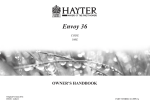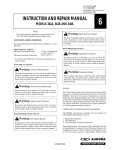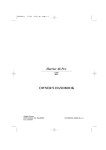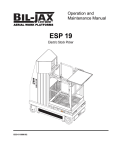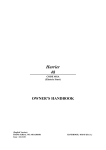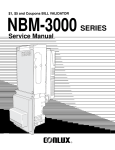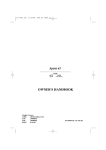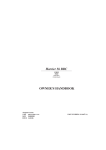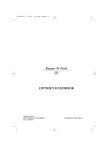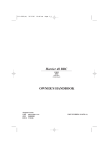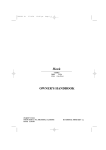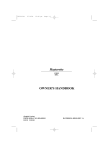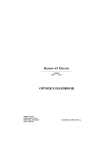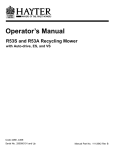Download Hayter Mowers 3401 Lawn Mower User Manual
Transcript
Harrier 56 CODES 340A 341A (Auto Drive) Electric Start (Variable Speed) OWNER'S HANDBOOK (English Version) FROM SERIAL NO: 340A001001, 341A001001 ISSUE 09.9.03 HANDBOOK: 340228 (REV .1.) MAIN FEATURES /SPECIFICATIONS Main Features 9 1. Spark Plug lead 2. Engine Cover 3. Air Cleaner 4. Fuel Cap 5. Oil Filler Cap & Dip Stick 6. Handle Securing Knob 7. Engine Start Grip 8. Engine Stop Lever 9. Handlebar 10. Ground Drive Clutch Lever 11. Key (341A Only) 12. Throttle Control 13. Grassbag Assembly 14. Rear Deflector 15. Serial No. Label 16. Height of Cut Lever 17. Battery (341A Only) 18. Muffler Guard 10 8 7 11 6 12 13 5 14 4 3 2 15 1 16 17 18 3D340A1 Specifications Code Engine Engine type Engine/Cutterbar speed Fuel type Fuel capacity Oil type Oil sump capacity Cutting width Cutting height Overall dimensions Dry Weight 1.2 340A Briggs & Stratton INTEK-55 111682-0165-E1 2800 rpm Unleaded petrol 1.5 litres SAE 30 engine oil 0.6 litres 560mm 10 - 60mm 1,511 x 591 x 1,156mm 50.5 Kg 341A Briggs & Stratton INTEK-55 111687-0166-E1 2900 rpm Unleaded petrol 1.5 litres SAE 30 engine oil 0.6 litres 560mm 10 - 60mm 1,511 x 591 x 1,156mm 53.5 Kg 1ST Year (12 months) We certify that this service has been carried out by an Authorised Hayter Service Dealer Date: 1ST Year (12 months) Owner s Name: Serial Number: Date: Note for dealer: Please retain this voucher for your records. 2nd Year (24 months) We certify that this service has been carried out by an Authorised Hayter Service Dealer Date: 2nd Year (24 months) Owner s Name: Serial Number: Date: Note for dealer: Please retain this voucher for your records. CONTENTS 1.2 Main Features/Specifications 1.5 Contents 1.6 Introduction 1.7 Warranty 1.8 - 1.11 Safety Precautions 1.11 Safety Symbols 1.11 Decal Symbols 1.12 Assembling the Mower 1.12 - Delivery Checklist 1.12 - Handlebar 1.12 - Grassbag Attachment 1.13 Before Starting the Engine 1.13 - Prevent Engine Damage 1.13 - Oil Type 1.13 - Check Oil Level 1.13 - Fuel Type 1.21 - 1.28 Mower Maintenance 1.21 - Engine 1.21 - Throttle Cable Adjustment 1.21 - Carburettor Adjustments 1.21 - Oil Service 1.22 - Air Cleaner Service 1.22 - Spark Plug Service 1.23 - Keeping Engine Clean 1.23 - Grassbag 1.24 - Deck Housing 1.24 - Securing Nuts and Bolts 1.24 - Clutch Cable Adjustment 1.25 - Lubrication 1.25 - Cutterblade Removal 1.26 - Cutterblade Assembly 1.26 - Cutterblade Sharpening 1.27 - Storage 1.28 - Battery Charging 1.29 - 1.30 Trouble Shooting 1.31 Declaration of Conformity 1.14 - 1.19 Operating The Mower 1.14 - Controls 1.14 - Starting Step 1 1.14 - Step 2 1.14 - Step 3 1.15 - Electric Start 1.15 - Forward Travel 1.15 - Turning 1.15 - Stopping 1.16 - Slopes 1.16 - Height of Cut 1.16 - Before Mowing 1.16 - Grassbag 1.17 - Without Grass Collection 1.17 - Heavy Growth 1.17 - Friction Disc 1.17 - Non-Grassed Areas 1.18 - 1.19 - Lawn Care Calendar - Guide Only 1.19 - Lawn Stripes 1.32 - 1.34 Parts List 1.35 Parts list Diagram 1.36 Customer Info/Notes 1.18 Maintenance Schedule 1.5 INTRODUCTION Thank you for purchasing a Hayter mower. The following pages are designed to help you gain safe and efficient service from your mower. IMPORTANT: This ‘Owners Handbook’ should be regarded as part of the mower as it gives essential information regarding mower safety, operation, maintenance and specifications. Read and understand this handbook prior to operating your mower for the first time. Make sure you are familiar with all the controls and points of regular maintenance. If you have any doubts, consult your local Hayter authorised dealer who will be pleased to give you assistance. IMPORTANT: This mower is designed solely for use in a domestic grass cutting environment. Use in any other way is considered as contrary to the intended use. Compliance with and strict adherence to the conditions of operation, service and repair as specified in this handbook also constitute essential elements of the intended use. This mower should be operated, serviced and repaired only by persons who are familiar with its particular characteristics and who are acquainted with the relevant safety procedures. The safety precautions listed in this handbook and all other generally recognised regulations on safety must be observed at all times. Any arbitrary modifications carried out to this machine may relieve Hayter Limited of liability for any resulting damage or injury. Hayter mowers are robustly constructed and designed for efficient economical performance under normal mowing conditions. Correct operation and maintenance will ensure a long and satisfactory service life. Prior to despatch from our factory every effort is made to ensure that your mower is delivered in perfect condition. Throughout this handbook all references to left and right are as viewed from behind the handlebar, in the direction of forward travel. This handbook is based on information available at the time of publication. HAYTER LIMITED reserve the right to amend product specifications without prior notification. 1.6 WARRANTY LIMITED WARRANTY Hayter Limited warrants to the original user/purchaser that this unit shall be free from defects in material and workmanship under normal use and service for a period of three years from the date of purchase. The manufacturer of major proprietry components ie. engines, gearbox / transaxle (where applicable) furnish their own warranty and services are provided through their authorised network. To qualify for the full benefit of the warranty, the warranty registration card must be returned within 14 days of purchase. Subject to the conditions and exclusions noted in this limited warranty, we shall at our option, repair or replace any warranted part during the applicable period. If you are in doubt or experience any difficulty, please consult a Hayter Authorised Service Dealer for clarification. To qualify for the extended warranty (second and third year) of the three year limited warranty the machine must have annual services carried out by an Authorised Hayter Service Dealer. These chargeable services should be carried out within 12 and 24 months of the date of purchase. Excluded from the extended warranty period are those items which are subject to normal wear and tear e.g. tyres, wheels, cutterblades, belts, cables, grassbags, sweeper/brushes, batteries and other consumable wearing parts. All consumer machines which are fitted with a genuine Hayter friction disc as original equipment before use, are covered by a Lifetime Warranty against the engine crankshaft bending. Note: friction washers, blade brake clutch (B.B.C) units and other such devices are not applicable. Only machines fitted with a genuine Hayter friction disc, which are used in accordance with the recommended operating and maintenance procedures, are covered. This warranty does not apply to any unit that has been tampered with, altered, misused, abused or used for hire, and will become invalid if non genuine Hayter parts are fitted. This warranty does not cover minor mechanical adjustments unless they are due to defective material or workmanship. Consult the Owner’s Handbook or a Hayter Authorised Service Dealer for assistance when making these adjustments. A warranty period of 90 days applies to machines used for commercial purposes. This limited warranty gives you specific legal rights and is in addition to any statutory rights to which you may be entitled and your statutory rights are not affected by this warranty. If you need additional information concerning this written warranty, or assistance in obtaining services, please write to : HAYTER LIMITED, Service Department, Spellbrook, Bishop’s Stortford, Hertfordshire CM23 4BU UK ONLY: Details of your local Hayter authorised dealer are contained in Yellow Pages and the Hayter website www.hayter.co.uk or contact contact:- Freephone 0800 616298. 1.7 Issue: 05.09.03 To make a warranty claim, return the unit to a Hayter authorised dealer along with proof of purchase stating the machine serial number and date of purchase. The service receipt(s) or this Owners Handbook with the 1st/2nd year service boxes fully completed, must be produced as proof of entitlement to the extended warranty period. Subject to the conditions and exclusions in this limited warranty, the authorised dealer will, at our option, repair or replace any warranted part within the duration of the warranty period. SAFETY PRECAUTIONS Safety Alert Symbol This safety alert symbol indicates important safety messages. When you see this symbol be alert to the possibility of injury. Carefully read the following and inform others. Your mower is perfectly safe if used correctly. Failure to observe the following precautions may result in serious injury. Training Before using the mower read the owners handbook carefully. Pay particular attention to the safety precautions. Ensure that you are familiar with the controls and the proper use of the equipment. Learn how to stop the mower quickly in an emergency. Never allow children or people unfamiliar with these instructions to use the mower. Never mow while people, especially children, or pets are nearby. Keep in mind that the user is responsible for accidents or hazards occurring to other people or their property. Preparation While mowing, always wear substantial footwear and long trousers. Do not operate the equipment when barefoot or wearing sandals. Thoroughly inspect the area where the mower is to be used and remove all objects which may be thrown by the machine. WARNING: Petrol is highly flammable. - Store fuel in containers specifically designed for this purpose. - Before starting the engine add fuel outdoors only. Never remove the cap from the fuel tank or add petrol while the engine is running or when the engine is hot. Allow the engine to cool for at least two minutes before refuelling. Do not smoke while refueling. - Do not attempt to start the engine if petrol is spilled or a smell of petrol is present. Move the mower away from the area of spillage and avoid creating any source of ignition until petrol vapours have dissipated. 1.8 SAFETY PRECAUTIONS Preparation - Always use fresh fuel. Stale fuel can block the carburettor and cause leakage. - Replace fuel tank and oil tank caps securely. A damaged cutterblade or loose fixing bolt are major hazards. Before use, always visually inspect the cutting mechanism to ensure that it is in good condition. A damaged cutterblade must be replaced immediately with a genuine Hayter replacement part Operation Do not operate the engine in a confined space where exhaust fumes (carbon monoxide) can collect. Refuel outdoors only and do not smoke while refuelling. Always pull the starter cord slowly until resistance is felt. Then pull the cord rapidly to avoid kickback and prevent hand or arm injury. Mow only in daylight or good artificial light. Avoid using the mower on wet grass, where feasible. Always be sure of your footing on slopes. Walk, never run. Mow across the face of slopes, never up and down. Exercise extreme caution when changing direction on slopes. Do not mow excessively steep slopes of more than 20 degrees. Use extreme caution when reversing or pulling the mower towards you. Stop the engine before moving the mower across areas other than grass. Never operate the mower unless the guards are securely in position and in good condition. Do not change the engine governor settings or overspeed the engine. Disengage the rear roller drive clutch before starting the engine. Start the engine carefully, with feet well away from the cutterblade. 1.9 SAFETY PRECAUTIONS Operation Do not tilt the mower when starting the engine. Do not put hands or feet near or under rotating parts. Never pick up or carry the mower while the engine is running. Never lift the rear deflector while the engine is running. Never touch the exhaust/exhaust guard or cooling fins when the engine is hot. Stop the engine and disconnect the spark plug lead: - Before clearing blockages or unclogging the discharge chute. - Before cleaning/checking or working on the mower. - After striking a foreign object. Inspect the mower for damage and ensure necessary repairs are made before re-starting. - If the mower starts to vibrate abnormally (check immediately). Stop the engine: - Whenever you leave the mower. - Before refuelling. Maintenance & Storage Keep all nuts, bolts and screws tight to ensure that the equipment is in safe operating condition. Frequently check fuel lines and fittings for cracks or leaks and replace if necessary. Never check for a spark when the spark plug is removed. (Use approved tester) Inspect the exhaust periodically and replace if worn or leaking. Never crank the engine with the spark plug removed. Never start the engine with the air-cleaner or air-cleaner cover removed. Never store the mower with petrol in the tank within an enclosed area where fumes may reach an open flame or spark. 1.10 SAFETY PRECAUTIONS Maintenance & Storage Allow the engine to cool before storing in any enclosure. To reduce the fire hazard, keep the engine and the surrounding deck area free of grass, leaves, or excessive grease. Check the rear deflector and grassbag frequently for wear or deterioration. Replace worn or damaged parts for safety. If the fuel tank has to be drained, this should be done outdoors and when the engine is cool. Wear strong work gloves when removing and reassembling the cutterblade. Always replace worn or faulty parts with genuine Hayter parts. Safety Symbols Danger of severing toes or fingers in cutting mechanism. Safety Alert - Be aware to the possibility of injury. Carefully read the Owners Handbook before using the machine. Stop engine and remove spark plug lead before working on the mower. Danger of being hit by thrown objects. Keep bystanders at a safe distance from the mower. Decal Symbols Engine Stop (Symbol) STOP Height of Cut Adjustment (Symbol) 305113 Throttle Control (Symbols) CS198 1.11 ASSEMBLING THE MOWER Delivery Checklist Remove the mower from the packaging and check that the following items have been supplied correctly. If any items are missing contact, your local Hayter dealer. 1. Engine Handbook. 2. Grassbag. 3. Charger (341A) 4. Ignition Key (341A) To prevent accidents cut off the long ribbon attached to the grassbag and discard. (341A Only) Note: Prior to first use please fully charge the battery for 14 hours. (Refer to battery charging) Handlebar Unscrew the handlebar securing knobs sufficiently to allow the handlebar to pivot. Hold the engine stop lever in towards the handlebar and unfold the handlebar to the operating position, before releasing. Tighten both handlebar knobs to secure in position. Take care to ensure that the control cables do not become snagged at the pivot point. Grassbag Attachment Raise the rear deflector, lower the grassbag through the handlebar and hook in position. Lower the deflector to rest on the grassbag 1.12 BEFORE STARTING THE MOWER Prevent Engine Damage To prevent engine damage the engine is shipped without oil or petrol. The engine must be filled with the correct grade of oil and petrol before starting the engine. Oil Type Check Oil Level 0.15 Litres ADD Clean around the oil filler cap before removing. With the mower on a level surface, unscrew and remove the oil filler - dipstick. Wipe oil from it with a clean cloth. Screw the oil filler - dipstick back in place, then unscrew and remove it to check the oil level. The oil level is correct when it is at the full mark on the dipstick. DO NOT OVERFILL. FULL OIL Always use high quality detergent oil classified SAE 30 oil. Never use additives with recommended oil. To prolong the life of your engine it is important that the oil is changed after the first 5 hours of use - refer to ‘Maintenance Schedule’. 15C Fuel Type Always use clean, fresh unleaded petrol. Purchase fuel in quantities that can be used within 30 days. Never mix oil with petrol. For added engine protection Briggs & Stratton recommend the use of their fuel additive which is available from an authorised Briggs & Stratton service dealer. Fill to base of neck to allow for fuel expansion. Do not overfill the fuel tank. 1.13 OPERATING THE MOWER Controls Operate all control levers several times and ensure that the cables move freely. Check that the engine stop and ground drive clutch levers return freely to their rest position when released. Whilst operating the engine throttle mechanism slight resistance should be felt when moving the lever to the ‘choke’ position. Starting - Step 1 Move the throttle control lever to the ‘choke’ position before starting a cold engine. Move the throttle control lever to the ‘fast’ position before starting a warm engine. Step 2 Stand behind the mower and hold the handlebar together with the engine stop lever with your left hand. With your right hand hold the engine start - grip and pull slowly until resistance is felt, then pull rapidly to crank the engine. carefully return the start grip to the storage position when the engine starts. If the engine does not start after 5 attempts - refer to “Trouble Shooting”. The engine stop lever must be held firmly against the handlebar to start and keep the engine running. If the engine stop lever is released the engine will stop. Step 3 Allow the engine to warm up and move the throttle lever to the ‘fast’ position after starting a cold engine. To prevent damage never pull the engine start grip when the engine is running. 1.14 OPERATING THE MOWER Electric Start (Electric start Only) Stand behind the mower and hold the handlebar together with the engine stop lever. Turn the ignition key in a clockwise direction and hold in position to crank the engine. When the engine starts release the key and move the throttle to the fast position after starting a cold engine. Note: Cranking the engine for more than 15 seconds in any one minute can damage the starter motor. If necessary the engine can be started manually without using the ignition switch. To prevent engine damage do not operate the ignition key when the engine is running. Forward Travel Hold the handlebar and operate the ground drive clutch lever to power the mower in a forward direction. When the ground drive clutch lever is disengaged the mower may be pushed. This feature is useful when mowing in confined areas. If the engine stop lever is released the engine will stop. Turning To make a wide turn steer the mower with the handlebar in the direction required. To make a tight turn release the ground drive clutch lever, apply downward pressure on the handlebar to raise the front wheels just above ground level and steer in the required direction. To prevent accidents do not raise the front of the mower excessively when making a turn. Never raise the rear of the mower when the engine is running. Stopping Release the ground drive clutch lever, reduce the throttle setting and release the engine stop lever. Emergency stop: Release both ground drive clutch lever and engine stop lever together. If the engine fails to stop, move the throttle lever to the ‘slow’ position and disconnect the spark plug lead. STOP 1.15 OPERATING THE MOWER Slopes To prevent engine damage do not use the mower on slopes greater than 20 degrees. Height of Cut 305113 To adjust the height of cut: Grip the lever and pull sideways to disengage it from the locking notch, then push forwards to lower or pull backwards to raise the height of cut. Finally release the lever at the required position and ensure it locks firmly into one of the nine setting notches. Always select a height of cut to suit operating conditions. Aim to prevent engine overloading and blockages by avoiding low cuts in long grass conditions. Be prepared to make two cuts when the grass is long. Before Mowing To prevent accidents, thoroughly inspect the area and remove all objects which when contacted by the mower cutterblade could become dangerous projectiles. Inspect the area for hidden obstructions which when contacted by the cutterblade could risk health and safety. Remember the location of these obstructions and ensure that you mow around them. Grassbag Raise the rear deflector and lift the grassbag through the handlebar and lower the rear deflector to rest against the rear of the mower. To empty the grassbag, pour out the grass clippings and shake the grassbag vigorously to clean the airways. Good grass collection depends on good air flow through the grassbag. When collecting grass clippings it is important that the grassbag is emptied regularly to prevent blockages and engine overloading. 1.16 OPERATING THE MOWER Without Grass Collection Remove the grassbag and operate the mower with the rear deflector in the closed position. Heavy Growth Areas of heavy growth should be mown without collecting the clippings. If collection is required, first mow the area without the grassbag at the maximum height of cut setting. Allow the grass clippings to dry out and then mow the area at the maximum height of cut setting with the grassbag fitted. Reduce the height of cut and mow the area again as necessary until the required finish is obtained. 305113 To prevent grass damage do not remove more than one third of grass height in one cut. Friction Disc The cutterblade is driven by the engine via a friction disc to help prevent damage occurring to the engine crankshaft and cutting mechanism when a hidden obstruction or overload is encountered. Always stop the engine when a hidden obstruction or excessive vibration is encountered. Disconnect the spark plug lead and examine the cutting mechanism. ALWAYS replace a damaged cutterblade - refer to “Maintenance”. Non-Grassed Areas When moving the mower across non-grassed areas, stop the engine and set the mower to the maximum height of cut to protect the cutting mechanism. STOP 1.17 LAWN CARE CALENDAR To be used as a guide only. January There is very little work to do this month apart from brushing away leaves. Keep off the grass if frozen or waterlogged. February Rake the grass thoroughly. Spike the lawn to aerate and stimulate soil organisms and root growth and apply lawn sand if necessary. March The yearly lawn work programme really starts this month. As soon as the ground conditions are suitable, the first cut can be made. The first cut should merely “top” the grass as close cutting at this stage could result in severe yellowing or browning. Two cuts are generally sufficient this month. April Mow often enough to stop grass growing away. Dig out patches of coarse grass or resistant weed. Re-seed bare patches. May Keep mowing increasing the frequency as required. Treat with selective weed killers or combined weed/feed preparations if you did not feed the lawn in April. June Summer mowing should now be under way. It should be necessary to mow the lawn twice a week. Raking before mowing is important this month as the combined action keeps runners of clover under control. Water the grass if necessary, and remember to soak thoroughly. July Treat the grass with the second application of fertiliser or weed killer/fertiliser. Water when necessary and rake occasionally. As a general rule the grass clippings should be removed each time you mow. If weather conditions are dry and hot and the grass is weed free, leave the clippings on the lawn to help maintain ground moisture. 1.18 LAWN CARE CALENDAR August Keep mowing regularly and watering as necessary. Fill any cracks caused by drought with a mixture of sharp sand and soil. In dry weather conditions leave the grass longer to help retain ground moisture. September Raise the height of cut to allow the grass to thicken and protect the roots from the winter frost and snow. October Rake out the thatch from the turf and spike the lawn to assist in drainage. Brush in peat and sharp sand. November Use a stiff broom to disperse worm casts before mowing. Keep turf free from leaves. December Apart from brushing away leaves, December is a slack end of a busy year. Keep off the lawn if it is very wet or frozen. Lawn Stripes 1 The way to achieve a neat striped effect is for the lawn being cut in parallel stripes, alternate stripes being mown in opposite directions. A much more important routine is to cut at right angles to the line of the previous mowing. If the work has been carried in a north-south line, then the next cutting should be in an east-west direction. The crosscutting keeps down the coarse weed grasses. 2 1CG480V05A To prevent grass damage do not remove more than one third of the grass height in one cut. 1.19 MAINTENANCE SCHEDULE Follow the hourly or calendar intervals, whichever occurs first. More frequent service will be required if working for prolonged periods under dusty, dry conditions, or when airborne debris is present or after extensive operation cutting tall, dry grass. First 5Hrs After the very first five hours change the engine oil Daily Check the oil level Remove grass debris from around the engine, exhaust/exhaust guard and air ways in the top cowl and underside of the deck housing. Remove grass debris from the grassbag and check for signs of damage. Check the condition of guards and safety devices. Check condition of cutterblade. 25Hrs or Every Season Change the engine oil if continuously operating under heavy load or high ambient temperature. Service the air cleaner. Lubricate wheels, pivot points and linkages and grease the inner control cables at point of entry and exit from their outer casing. Check the clutch cable adjustment. Sharpen the cutterblade. 50Hrs or Every Season Change the engine oil. 100Hrs or Every Season Clean the engine cooling system. Clean more often under dusty conditions or when airborne debris is present or after prolonged operation whilst cutting tall, dry grass. Replace the spark plug. 1.20 MOWER MAINTENANCE To prevent accidents stop the engine and disconnect the spark plug lead before attempting to carry out maintenance procedures on the mower. Engine 1. 2. 3. 4. 5. 6. 7. 8. 9. 10. Engine Cowl Spark Plug / Lead Carburetor Exhaust Guard Exhaust Oil fill/Dipstick Start Grip Fuel Cap Finger Guard Air Cleaner 8 9 7 6 10 1 2 3 4 5 Throttle Cable Adjustment Loosen casing clamp screw (1) and move the governor lever (2) in the direction of screw (1) as far as posible. Move the throttle control to the choke position. Tighten casing clamp screw. 1 2 Carburettor Adjustments Should only be made by an authorised Briggs & Stratton dealer. Under no circumstances should the engine be adjusted to run at a speed in excess of that shown on the Declaration of Conformity. 1.21 MOWER MAINTENANCE Oil Service Check the oil level daily before starting the engine and ensure that the correct oil level is maintained. Refer to-‘Before Starting the Mower’ for oil checking and filling instructions. Change the engine oil after the first 5 hours of operation and thereafter according to the ‘Maintenance Schedule’:1. Drain fuel by running the engine until the fuel tank is empty. 2. Remove the spark plug lead. 3. Allow the engine to cool. 4. Drain the oil while the engine is warm (not hot). 5. Tip the mower over on to its left hand side thus ensuring that the air cleaner is kept uppermost to prevent engine damage. 6. Remove the oil filler dipstick and drain the oil into a suitable container. 7. Refill with new oil of the recommended SAE viscosity grade. (Refer to-‘Before Starting the Mower’) Air Cleaner Service 1 2 3 4 To service the air cleaner, loosen the two screws (1) and remove cover (2). Carefully remove pre-cleaner (3) and cartridge (4) wash in a solution of liquid detergent and water. Allow to air dry thoroughly before fitting. 5 If very dirty, replace. - Do not use petroleum solvents. - Do not use pressurised air. - Do not oil the cartridge. After servicing, install the pre-cleaner and cartridge in the assembly base (5). Replace the cover and securely tighten the screw to the base. 1.22 MOWER MAINTENANCE Spark Plug Service Use only Briggs & Stratton spark tester (1) to check for a spark as shown in the diagram. Replace the spark plug every 100 hours or every season, whichever occurs first. A spark plug wrench is available from any authorised Briggs & Stratton service dealer. 1 Check the spark plug gap with a feeler gauge and set at 0.76mm. Keeping Engine Clean Remove all grass and debris from the engine including the exhaust/exhaust guard, the air ways in the top cowl and the surrounding deck areas on a daily basis after use. Never spray the engine with water during cleaning. Water can contaminate the fuel. Always clean with a brush or compressed air. Grass and debris may clog the engine’s air cooling system especially after prolonged operation while cutting tall, dry grass. The internal cooling fins and surfaces may require cleaning to prevent overheating and engine damage. We recommended that this service be carried out by an authorised Briggs and Stratton dealer. Grassbag Remove grass debris from the grassbag immediately after use and check its condition for signs of damage. To prevent accidents replace a damaged grassbag immediately. 1.23 MOWER MAINTENANCE Deck Housing Remove grass debris from the top and underside of the deck housing immediately after use. Fertilisers and top dressings are particularly corrosive. Thoroughly clean the mower deck immediately after use on treated grass and store well away from corrosive materials. Securing Nuts & Bolts Regularly check that all securing nuts and bolts are tight. Replace missing or damaged items immediately. 1CG480V36B Clutch Cable Adjustment 32-38mm Auto Drive Models Only. Check the clutch cable operation every 25 operating hours and adjust if necessary. The clutch cable is adjusted correctly when the belt drive just engages with the clutch lever positioned 32-38mm from the handlebar. Set the plastic adjuster (A) as necessary. If further adjustment is required, unscrew the lock nuts (1) and screw the adjuster (2) in or out as necessary. Tighten the locknuts (1) when correctly adjusted. A 1 2 1.24 MOWER MAINTENANCE Lubrication Lubricate the wheels, pivot points and linkages with engine oil every 25 operating hours. Apply a good quality medium grease to the inner control cables at the point of entry and exit from their outer casing. Cutterblade Removal Drain the fuel by running the engine until the fuel tank is empty and the engine stops. Remove the spark plug lead and allow the engine to cool. Turn the mower on its left hand side and ensure that the air cleaner side of the engine is uppermost. Firmly grip the end of the cutterblade with the gloved hand and remove the bolt, spring washer and distance piece securing the cutterblade with a 9/16” A/F spanner. 1CG480V33C To prevent accidents never work on the cutterblade unless the spark plug lead has been removed. The cutterblade has sharp edges. ALWAYS wear strong gloves to protect your hands when working on the cutterblade. DO NOT rotate tools towards the cutting edges to avoid the risk of injury should the tool slip. ALWAYS use genuine Hayter replacement parts. The condition of the cutterblade and its mounting arrangement should be checked regularly for signs of wear or damage. Ensure that the cutterblade is not bent or cracked. A damaged cutterblade that is out of balance will vibrate excessively and may break. DO NOT use an unbalanced cutterblade. Regularly check that the bolt securing the cutterblade is tightened to the specified torque of 54Nm. Replace the cutterblade every 2 years of sooner if excessively worn or damaged. To prevent injury it is wise to seek assistance when turning the mower on its side. 1.25 MOWER MAINTENANCE Cutterblade Assembly Assemble the cutterblade with the turned up edges facing towards the engine. Secure the cutterblade using the bolt (1), spring washer (2), and distance piece (3) and tighten to a torque of 54Nm 1 2 3 Cutterblade Sharpening 30°-45° A slightly worn cutterblade may be re-sharpened. Both blade edges must be sharpened equally to ensure balance. Sharpen the cutterblade every 25 mowing hours or more frequently if conditions require. Remove the cutterblade from the mower and clean using a brush and water. Inspect the cutterblade for signs of damage. Sharpen both cutting edges with a flat file to restore performance. Ensure that the cutterblade is balanced. Use a screw driver with a round shaft to support the cutterblade through its centre hole. Hold the cutterblade horizontal and then release. A balanced cutterblade will remain horizontal. If the cutterblade is not balanced the heavy end will rotate downwards. Sharpen the heavy end until the cutterblade is correctly balanced. 1.26 MOWER MAINTENANCE Storage To store the handlebar unscrew the 2 small securing knobs sufficiently to allow it to be pivoted forwards to rest against the mower. Take care to ensure that the control cables do not become snagged at the pivot point and depress the engine stop lever to prevent it being damaged through contact with the engine spark plug. Engines stored in excess of 30 days need to be protected with Briggs & Stratton fuel additive or drained of fuel to prevent gum from forming in the fuel system or on essential carburettor parts. To ensure your mower is maintained in good working order it is important that the following procedure is adopted. Refer to the Maintenance section as necessary. Drain fuel from the engine by operating the engine until it stops. Disconnect the spark plug lead. Change the engine oil. Remove the engine spark plug and pour 15ml of engine oil into the engine cylinder and replace the spark plug. Do not exceed the stated volume of oil as engine damage may occur on re-starting. Do not replace the spark plug lead. Slowly pull the engine start - grip once to crank the engine. This will distribute the oil and help prevent engine corrosion. Clean grass and debris from the engine cylinder, cylinder head cooling fins, under top cowl, and around and behind exhaust/exhaust guard. Clean all other areas of the mower and ensure that the grassbag is clean. Lubricate the mower. Treat metal parts with a water repellent anti-corrosion product. Cover the mower with a protective sheet and store it in a dry, ventilated area. (Electric Start Only) Charge the battery Disconnect the battery leads 1.27 MOWER MAINTENANCE Battery charging 14hrs PREVENT ACCIDENTS: ALWAYS charge the battery in a well ventilated area. NEVER charge the battery near naked flames or direct heat. ALWAYS switch off the mains electricity supply before disconnecting the charger from the battery. ALWAYS use the battery charger supplied with the mower. Battery charging should not be necessary during normal use. The engine operation will automatically charge the battery. If the mower is stored for a long period recharging the battery may be necessary to permit electric starting. Charge the battery only when necessary. To recharge the battery: Disconnect the battery lead from the mower lead and then connect the battery lead to the charger. Connect the charger plug to the mains electricity supply and switch on to charge the battery for a 14 hour period. Switch off the mains electricity supply and disconnect the charger plug. Disconnect the battery lead from the charger and then connect the battery lead to the mower lead. IMPORTANT - PREVENT DAMAGE: NEVER connect the battery charger to the engine lead as this will cause the charger to be permanently damaged. Chargers damaged in this manner will not be replaced under warranty. CAUTION - PREVENT ENVIRONMENTAL DAMAGE: The battery has a separate collection mark. This indicates that the used battery must be taken to an authorised disposal site. It must not be disposed of with general waste. WS032 1.28 TROUBLE SHOOTING PROBLEM POSSIBLE FAULT REMEDY Engine will not turn over Engine stop lever released. Operate engine stop lever. Incorrect oil level. Check oil level. Obstruction under deck. Remove obstruction. Battery discharged (341AOnly) Charge battery Engine smokes Engine runs then stops Engine will not start Excess oil level. Check oil level. Air cleaner cartridge oil soaked or blocked. Service air cleaner. Fuel starvation. Fill fuel tank. Fuel cap vent blocked. Clean fuel cap vent. Engine under load. Raise height of cut. Fuel starvation. Fill fuel tank. Engine cold. Set throttle to ‘choke’ position. Incorrect/contaminated fuel. Drain fuel tank and fill with correct fuel. Spark plug lead disconnected. Connect spark plug lead. Throttle setting incorrect. Set throttle to ‘fast’ position. Engine brake not released. Operate engine brake lever. Faulty spark plug. Clean and adjust gap or replace. Battery discharged (341A Only) Charge battery Engine runs rough Wiring fault. Check wiring. Spark plug lead becoming disconnected in use. Connect spark plug lead. Faulty spark plug. Clean and adjust gap or replace. Air cleaner blocked. Service air cleaner. Incorrect/contaminated fuel. Drain tank and fill with correct fuel. 1.29 TROUBLE SHOOTING PROBLEM POSSIBLE FAULT REMEDY Engine vibrates excessively Mounting bolts loose. Tighten bolts Cutterblade bolt loose. Tighten bolt Cutterblade out of balance. Balance cutterblade Bent crankshaft. Consult your dealer Undulating ground conditions Change direction of travel Cutterblade worn Sharpen the cutterblade Cutterblade out of balance Balance the cutterblade Wheels / roller damaged Inspect and replace as necessary Grass is wet Mow dry grass Cut height too low Increase cut height Grassbag full Empty grassbag Airflow through the grassbag is restricted Clean the grassbag Engine speed too slow Set throttle to fast position Cut height too low Increase cut height Wheels / roller damaged Inspect and replace as necessary Clutch out of adjustment Adjust clutch cable Drive belt damaged Replace drive belt Airflow through the grassbag is restricted Clean the grassbag Discharge chute blocked Remove blockage Wet grass Mow in dryer conditions Grassbag full Empty grassbag Engine speed too slow Set throttle to fast position Uneven cut Discharge chute blocks Mower is hard to push Mower will not self propel (Autodrive Only) Poor grass collection 1.30 DECLARATION OF CONFORMITY EC DECLARATION OF CONFORMITY HAYTER LIMITED, Spellbrook, Bishop’s Stortford, Herts CM23 4BU ENGLAND declare that the lawnmowers: Models: Machine Type No. Category: Type: Engine - Manufacturer: - Speed of rotation: Width of cutting device: Speed of rotation of the cutting device: Harrier 56 CODE 340A Auto Drive Pedestrian Rotary Briggs & Stratton 2800 rpm 560mm 2800 rpm Harrier 56 CODE 341A Auto Drive Electric Start Pedestrian Rotary Briggs & Stratton 2900 rpm 560mm 2900 rpm Complies with the provisions of Directive: 98/37/EC Essential Health & Safety Requirements Relating to the Design & Construction of Machinery and Safety Components, as amended and the regulations transposed into national law. Also Directive 89/336/EEC Electromagnetic Compatibility, as amended and the regulations transposed into national law. Also Directive 2000/14/EC Noise emission in the environment by equipment for use outdoors, and the regulations transposed into national law procedure applied for the conformity assessment: ANNEX VI, procedure 1. Notified Body: Sound Research Laboratories Ltd. Holbrook House, Little Waldingfield, Sudbury, Suffolk, ENGLAND Notified body identification No: 1088 Measured sound power level: Guaranteed sound power level: 92 dB(A) 100 dB(A) 92 dB(A) 100 dB(A) Standards Used: EN292, EN836 and ENISO14982. Authorised Signatory: Signed M.A. Wright (Technical Director) Date: 03.10.01 Declaration done and Technical Documentation kept at: HAYTER LIMITED, Spellbrook, Bishop’s Stortford, Herts CM23 4BU ENGLAND VIBRATION INFORMATION Lawnmower vibration information. RMS acceleration measured in 3 - axes at operators contact position on the handlebars. CODE 340A = 10.6 ms-2.. CODE 341A = 10.6 ms-2.. 1.31 PARTS LIST QTY. ITEM NO. 1 2 3 4 5 6 7 8 9 10 11 12 13 14 15 16 17 18 19 20 21 22 23 24 25 26 27 28 29 30 31 32 33 34 35 36 37 38 39 40 41 42 1.32 DESCRIPTION PART NO. Belt Circlip - 5/8” Woodruff Key Washer - 3/16” Spring Cutterblade Washer - Plain 5/8” Spring Clip -5/16” Bush - 1/2” x 5/8” x 3/4” Screw - M6 x 12 Csk. Pozi Taptite Wheel Hub Cap Nut - M6 Nylon Insert ‘T’ Type Screw - M6 x 20 Hex Hd. Taptite Washer - 1/2” Plain Friction Disc Washer - Plain 5/16” Washer - Plain 1/2” Washer - Plain M6 Clamp - Handlebar Circlip - 3/4” Circlip - 1/2” Pin - Roll 3/16” x 3/4” Screw - Taptite 3/8” UNC x 1.1/4” Setscrew - Hex Hd.3/8” UNF x 1.1/4” Nut - Nylon Insert 1/2” UNF Washer - Starloc 5/16” Knob - Height Adjuster Washer - Spring 3/8” Pulley Spring Screw - Pozi Pan Screw - Hex Hd. Taptite M6 x 16 Frame - Rear Roller Bolt - Coach M8 x 40 Screw - Washer Hd Taptite M6 x 12 Nut - M8 Nylon Insert ‘T’ Type Rivet Bolt - Coach M6 x 20 Bolt - Hex. Hd. M6 x 30 Screw - 6mm x 20 Bolt - Coach M8 x 45 340049 1428 1662 09257 5421 340015 09286 04020 4452 09545 5218 219143 09544 09575 02575 219203W 09266 09280 09472 340028 02708 03096 03997 09349 09116 4486 0201086 330053 09273 219111 1246 09780 09365 340044 09379 09546 09441 09320 09668 09547 09687 226024 340A 341A 1 1 1 4 2 1 1 1 1 4 2 2 1 2 1 1 1 2 5 2 2 1 4 3 1 2 2 1 1 1 1 1 23 1 2 2 2 4 2 1 2 2 1 1 1 4 2 1 1 1 1 4 2 2 1 2 1 1 1 2 5 2 2 1 4 3 1 2 2 1 1 1 1 1 23 1 2 2 2 4 2 1 2 2 ITEM NOTE PARTS LIST QTY. ITEM NO. 43 44 45 46 47 48 49 50 51 52 53 54 55 56 57 58 59 60 61 62 63 64 65 66 67 68 69 70 71 72 73 74 75 76 77 78 79 80 81 82 DESCRIPTION Distance Piece Washer - Nylon 19mm Mainframe Assembly Throwplate Idler Sprocket Sleeve Assembly Plate - Ratchet Cable - Engine Brake Cap - Nut Handlebar - Lower LH Jockey Lever Sprocket - 10 Teeth Plate - Securing Woodruff Key Rod - Connecting Axle - Front Assembly Bearing Moulding Plate - Securing Pulley -Jockey Sprocket - 17 Teeth Handlebar - Lower RH Engine - Compliance A.P.T.O. Engine - Compliance A.P.T.O. Spacer Electric Start Cover - Transmission Coupling Bearing Housing Moulding Pulley - Assembly Bracket - Belt Guide Chain Cover - Transmission Underguard Deflector - Rear Rod - Pivot Spring - Deflector Nut - Plain M6 Insert - Front Fin Rope Guide Lever - Clutch Nut - M6 Nyloc Insert Washer - Spring M6 PART NO. 4014 09688 340205V 340011 219095 340102 341031 234051 340103 219023 219106 219028 5321 340014 340020 219036 219037 219156 219051 340104 346040 341037 219053 341038 219055 340109 219060 340105 219064 219054 340050 340051 340022 340024 340052 09437 340190 305093 306094W 09438 09474 340A 341A 1 2 1 1 1 1 1 2 1 1 1 1 1 1 1 2 2 1 1 1 1 0 1 0 1 1 1 1 1 1 1 1 1 1 2 3 1 1 1 1 3 ITEM NOTE 1 2 1 1 1 1 1 2 1 1 1 1 1 1 1 2 2 1 1 1 0 1 1 1 1 1 1 1 1 1 1 1 1 1 2 3 1 1 1 1 3 1.33 PARTS LIST QTY. ITEM NO. 1.34 DESCRIPTION PART NO. 340A 341A 83 84 85 86 87 88 89 90 Decal - Caution Handwheel Grassbag - Fabric Cable - Clutch Tube Plug Roller Bearing Housing Cover - Grassbag Grassbag - Assembly 219189 226013 340071 341034 300160 219102 340072 340070 1 2 1 1 2 2 1 1 1 2 1 1 2 2 1 1 91 92 93 94 95 96 97 98 99 100 101 102 103 104 105 106 107 108 109 110 111 112 113 114 115 116 117 118 119 Cable Tie Brush Seal Handle - Grassbag Frame - Grassbag Assembly ‘U’ Tube Decal - Hayter & Royal Warrant Oilite Bush - Roller Roller - Assembly Spacer - Nylon Wheel - Roller Free Bush Locknut Roller Shaft Shroud Freewheel Rope Stop Lever - Engine Pin - Pivot Handlebar - Upper Decal - Engine Stop Charger Decal - Engine Throttle Control & Cable Battery 12V Clip - Battery Rivet - Avdel Bracket - Battery Key - Ignition Drive fasteners Decal - Grass Blade 3966 340082 340073 340075 340078 410087 340129 340139 340149 340150 340154 340163 340162 340168 MU42189 340179 340182 341029W 331046 226006 340224 341028 220015 220014 09318 220013 6426 300144 410064 3 1 1 1 1 1 2 2 2 2 2 1 1 1 1 1 2 1 1 0 1 1 0 0 0 0 0 2 1 3 1 1 1 1 1 2 2 2 2 2 1 1 1 1 1 2 1 1 1 1 1 1 1 2 1 1 2 1 ITEM NOTE (Includes4, 38, 85, 89, 93, 94 & 95) PARTS LIST 108 41 80 109 44 106 44 41 107 112 107 81 79 118 19 42 111 105 65 91 13 86 87 49 84 50 117 32 87 62 42 37 20 93 38 89 91 63 112 119 95 4 38 63 85 49 50 67 37 38 51 90 20 113 76 4 74 33 83 33 23 3 115 114 116 75 36 76 72 28 39 45 23 94 14 70 101 96 68 31 35 82 92 97 100 5 19 77 48 10 24 99 88 98 104 99 100 5 7 55 12 26 33 46 33 16 6 43 57 59 33 33 56 29 33 78 33 27 25 8 64 2 30 86 66 36 52 21 69 1 15 22 60 18 33 97 10 31 53 82 19 54 46 18 9 58 103 71 61 21 47 40 56 102 88 73 11 34 59 17 27 77 33 52 33 11 340S/341S1 26 12 1.35 CUSTOMER INFORMATION /NOTES Serial No: Engine Type:-111682-0165-E1 (340A) Engine Type:-111687-0166-E1 (341A) Date of Sale:Your Local Dealer:- Notes:- 1.36 Engine:- Briggs & Stratton INTEK-55 Engine:- Briggs & Stratton INTEK-55




































